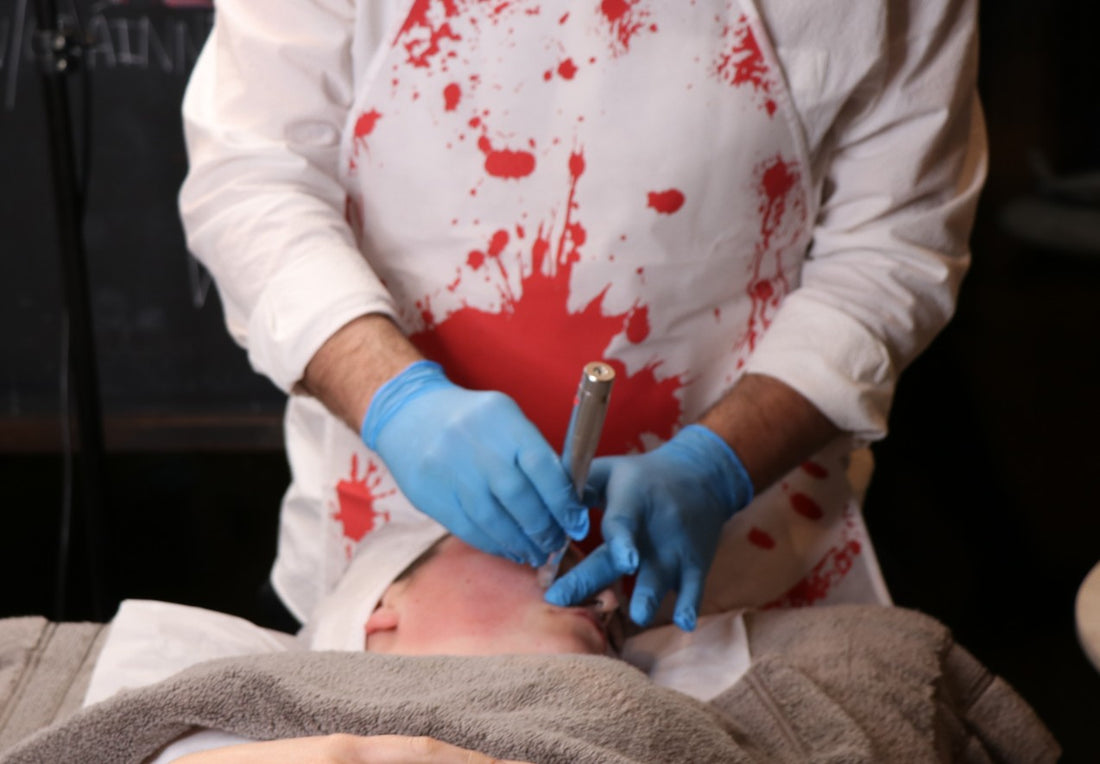
What Is Microneedling?
Our Bloody Gorgeous Event was a House of Horror for many reasons - but one of our spookiest and most intriguing haunted rooms was where Nerd Ben performed microneedling on a willing victim... We mean client, of course. It’s a fascinating process to watch, and it does beggar the question: what exactly is microneedling?
If you’re treatment-obsessed, you’ll have heard of it and maybe indeed have had it. Although to some it may seem borderline barbaric, it has very logical benefits.
What Is Microneedling?
Microneedling is also known as ‘collagen induction therapy’, which means that it encourages the production of collagen - handy! It’s also known as dermarolling, which might be a term you’re more familiar with. The Dermaroller is a brand so we opt to call the technique itself microneedling.
Microneedling uses super-fine needles to create hundreds of tiny, invisible punctures on the surface of the skin. This trauma to the surface of the skin stimulates the skin’s natural healing processes and can lead to both increased collagen and elastin production as a result of stimulation of the TGF beta1 (growth factor).

Microneedling is used as a treatment for those looking to reduce signs of ageing in their skin and those looking to improve the appearance of their pores. It helps to lessen the appearance of acne scarring, improve skin elasticity and diminish the appearance of wrinkle depth as it allows the skin to regenerate itself.
There are several ways to go about microneedling. You can visit a microneedling practitioner, and they might choose to use a specialist manual or electronic microneedling device depending on their preference or training.
Another thing to note - microneedling shouldn’t really be considered INSTEAD of using results-driven skincare, more in conjunction. Because microneedling makes the skin do the work, your skin needs to be healthy. If your skin doesn’t have the right nutrients to keep itself healthy and to repair itself well, microneedling just won’t be as beneficial.
What Is The Microneedling Process?
The process begins with you filling out a medical questionnaire surrounding the contraindications and implications of microneedling. Then the skin is cleansed and prepared by your practitioner. Once this is completed, if your treatment is being carried out by a nurse or doctor, your skin will be numbed with a topical cream that may take anywhere between thirty minutes and an hour to numb you enough.
This step is optional - but Ben, our devoted microneedling nerd shudders at his memories of going without numbing before. However, as Ben reminded us during our microneedling Facebook Live at Bloody Gorgeous, he’s a man, and therefore his pain threshold is lower than that of a woman. Well Ben, you said it, not us. But we’d probably still go for the numbing ourselves.
Once your practitioner removes this cream, the needling can begin!
The needling process is the use of a microneedling device on the skin to create tiny pin-prick wounds to the surface of the skin in a specific pattern, repeated several times at the practitioner’s discretion. The skin may bleed a small amount.
In our opinion, some blood is important - blood shows that growth factors have been triggered, and there is research for and against bleeding when you’re being needled, but erythema (redness) is a must to ensure that you have microneedled correctly. The session can take up to one hour, but could be as short as twenty minutes, depending on whether you’re having it carried out on a localised area or in more places.
Would we describe the sensation as pain? Yes, as it can be uncomfortable, particularly in areas where the skin is thinner, such as the under-eye area or the nose.
After the procedure, if performed correctly, your skin will be a bit red and inflamed for a day or two, but there is no significant downtime, and you can resume normal skincare activities 48 hours after the procedure.
Microneedling Aftercare
When it comes to aftercare, you really need to be careful not to allow bacteria to get near you for the first 24 - 48 hours, because the microchannels are essentially wounds. That means being careful when you’re opening the dishwasher, keeping the cat away from your visage no matter how much he or she whines and washing your hands thoroughly before touching it or applying any skincare. It also means no kissing beardy men - fact!

On top of that, you shouldn’t apply any skincare in that 48 hour period (hyaluronic acid is okay), even chemical SPF so it’s recommended that you stay away from any sunlight if you can, especially when your skin will be light-sensitive in this time.
An extra note: it’s best to drop your exfoliants including exfoliating cleansers for a week after having microneedling done, as you won’t need it and it’s possible they could irritate you. Check with your microneedler and include the pH and percentage of the acid you intend on using, so they can let you know if they think you're okay to use your acids.
How Long Does It Take To See Effects?
Microneedling works by triggering what we call the healing cascade, which is when the body senses inflammation and sends growth factors to the area and ups the production of collagen and elastin by affecting the structure of the skin. These proteins and growth factors will plump up the skin and make it appear smoother. Another effect will be increased skin cell turnover, for brighter, smoother, newer skin.
You may start to see effects as soon as two weeks afterwards and the effects can be permanent. Usually, after a course of microneedling, you’ll see the optimum results for up to 12 months.
What’s Microneedling Good For?
Professional microneedling devices can penetrate as deep as 1mm for the face and 2mm for the body, which can create amazing results when it comes to minimising the appearance of acne scarring, and improving the appearance of lines, wrinkles and pigmentation. Pore size may also be reduced as the skin’s elasticity can be improved!
Who Shouldn’t Be Microneedled?
- Pregnant hoomans due to the numbing and the trauma effect (the healing cascade)
- Those suffering from psoriasis or other skin conditions (check with your GP!)
- Those taking isotretinoin (RoAccutane, Accutane)
- Those who have MS, diabetes or other conditions that impair healing or could be affected by the sensory effect of the numbing
- Those with keloid scarring cannot have keloid scars treated due to the synthesis of collagen which may make keloids worse
- Those with open wounds or infections (ie. acne, cold sores, contact dermatitis) as it will spread bacteria or the virus across your face, but microneedling is fantastic for scarring once these have healed fully
Should Everyone Microneedle?
Unless you fit into a category of hooman for whom microneedling is not advised, it’s a really useful and fairly universal treatment. It’s something which makes a great investment in your skin as the results are really noticeable. Some people require six or more sessions to get their desired result, but some may be content with two or three sessions.
If you’re planning a wedding, microneedling is a really good treatment to consider. We recommend testing it out a year to six months in advance of your wedding and seeing how your skin responds, and then following it up with maintenance sessions after.

It’s important to ensure your skin is prepped for microneedling to work its magic. If skin has better levels of vitamin A and a healthy lipid barrier, and if your body is nourished well, microneedling will have a much better effect as it leans on your body and skin to carry out the effects.
If you’re a smoker looking to improve lines, wrinkles or pore size, microneedling may not be that beneficial as smoking continuously introduces free radicals to your body. Free radicals break down collagen and elastin, the very two proteins microneedling is looking to bring back. It’s not going to do you any harm to remain a smoker while having microneedling done, but it won’t really do you much good either.
Choosing A Practitioner
For the most part, we don’t provide specific recommendations of places to have microneedling done, because we simply don’t know every place that carries it out in the country or the world! What we do recommend is finding reviews of wherever your researching, speaking to them about it and asking to see previous results.
The Nerdie Conclusion
Microneedling is, in our opinion, one of the most effective treatments out there. BUT, and it’s a big but, it’s only as effective as the home skin care routine that’s allowing the skin to be healthy and repair itself post-needling. Additionally, the hooman carrying out microneedling makes a difference, but as far as treatments go, it is very hooman reliant.
Happy needling!
An extra nerdie note about home needling
Home-rolling or home microneedling is an absolute no-go. However, we do promote a concept that seems similar but is actually very different. It’s the Environ RollCIT, a wheel with short-depth needles that work to increase the penetration of the vitamin A when your skin has been made more compact by using the Environ AVST range consistently. The RollCIT does not increase stimulation of collagen or elastin directly, and is only needed for those using the fat form of vitamin A, retinyl palmitate.
When you’re using retinyl palmitate, over time, it essentially “seals” the stratum corneum together which is a huge benefit. But, this also means there is a barrier getting in the way of products penetrating to their best advantage. The purpose of using the RollCIT is for enhancing product penetration, not for stimulating collagen!

The needles on the RollCIT are more spread out than you’d find on an at-home roller which is better for the penetration of vitamin A. If you’re using the AVST range and are interested in rolling, Environ (and we) recommend that you begin rolling when you’ve finished your second bottle of AVST. If you progress through levels without rolling you are not truly benefitting from the higher level of vitamin A, unless you have exfoliating acids in your routine as these will also increase the penetration of the vitamin A.
As retinol doesn’t strengthen the skin in the same way that retinyl palmitate does, there is no need for rolling. However, for the most part, we prefer retinyl palmitate in a step-up programme so as to avoid the irritation and dryness associated with retinol.
